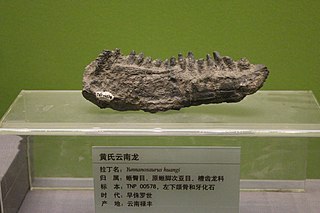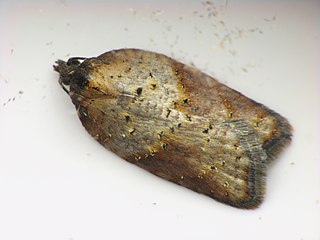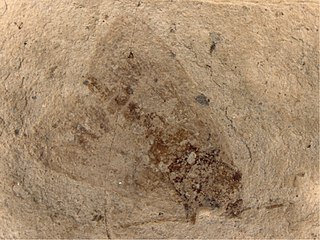
Yunnanosaurus is an extinct genus of sauropodomorph dinosaur that lived approximately 201 to 168 million years ago in what is now the Yunnan Province, in China. Yunnanosaurus was a large sized, moderately-built, ground-dwelling, quadrupedal herbivore, that could also walk bipedally, and ranged in size from 7 meters (23 feet) long and 2 m (6.5 ft) high to 4 m (13 ft) high in the largest species.

Kelmayisaurus is an extinct genus of carcharodontosaurid theropod dinosaur from the early Cretaceous. It was roughly 9–11 meters Its name refers to the petroleum-producing city of Karamay in the Xinjiang province of western China near where it was found.

In zoology and botany, a paratype is a specimen of an organism that helps define what the scientific name of a species and other taxon actually represents, but it is not the holotype. Often there is more than one paratype. Paratypes are usually held in museum research collections.

Panorpa is a genus of scorpion-flies that is widely dispersed, especially in the Northern hemisphere. However, they do not occur in western North America. Thirteen species occur in eastern Canada.
Sarcohyla cembra, also known as the Southern Sierra Madre treefrog, is a species of frog in the family Hylidae. It is endemic to Mexico. Until recently, it was only known from two male specimens: one from its type locality on the Pacific slopes of the Sierra Madre del Sur, Pochutla District, Oaxaca, and another one from Sierra de Yucuyacua south-east of Llano de Guadalupe, in north-west Oaxaca. The two locations are about 172 km (107 mi) apart. After having not been seen after 1993, it was feared that the species might be extinct. However, the species was rediscovered in field surveys in 2011–2012, extending its range with a new locality about 10 km north of the type locality.
Lozotaenia is a genus of moths in the tribe Archipini.

Epinotia is a very large genus of tortrix moths. It belongs to the tribe Eucosmini of subfamily Olethreutinae.
Gnorismoneura is a genus of moths belonging to the subfamily Tortricinae of the family Tortricidae.

The Tortricini are a tribe of tortrix moths.
Eosopostega issikii is a species of moth of the family Opostegidae. It is known only from the Izu Peninsula in south-central Honshu and from Kagoshima at the south-western tip of Kyushu.

Zhuchengtyrannus is a genus of tyrannosaurid theropod dinosaur known from the Late Cretaceous period of Shandong Province, China. It belongs to the tyrannosaurinae subfamily, and contains a single species, Zhuchengtyrannus magnus.

Paleolepidopterites is an extinct genus of moths from the family Tortricidae which are known from fossils found in Russia and the United States. The genus contains three species Paleolepidopterites destructus, Paleolepidopterites florissantanus, and Paleolepidopterites sadilenkoi, which were originally placed within the genera Tortrix and Tortricites respectively. The three species were formally redescribed in 2018.

Bittacus is a genus of hanging flies in the order Mecoptera. Members of the genus have a cosmopolitan distribution.
Yueosaurus is an extinct genus of basal ornithopod dinosaur known from Zhejiang Province, China.

Eumetabolodon is an extinct genus of procolophonine procolophonid parareptile from early and middle Triassic deposits of Nei Mongol, northern China. Two species of Eumetabolodon were named by J. L. Li in 1983 and the type species is Eumetabolodon bathycephalus.

The Stenophlebiidae is an extinct family of medium-sized to large fossil odonates from the Upper Jurassic and Cretaceous period that belongs to the damsel-dragonfly grade ("anisozygopteres") within the stem group of Anisoptera. They are characterized by their long and slender wings, and the transverse shape of the discoidal triangles in their wing venation.

The Tarsophlebiidae is an extinct family of medium-sized fossil odonates from the Upper Jurassic and Lower Cretaceous period of Eurasia. They are either the most basal member of the damsel-dragonfly grade ("anisozygopteres") within the stem group of Anisoptera, or the sister group of all Recent odonates. They are characterized by the basally open discoidal cell in both pairs of wings, very long legs, paddle-shaped male cerci, and a hypertrophied ovipositor in females.
Paracroesia abievora is a moth of the family Tortricidae. It is found in Japan and the Russian Far East.
Amorbia monteverde is a species of moth of the family Tortricidae. It is found from Costa Rica to Veracruz in Mexico, where it is found at altitudes between 1,000 and 1,650 meters.
Archips issiki is a species of moth of the family Tortricidae. It is found in China, South Korea, Japan and Russia (Ussuri, Primorye).











